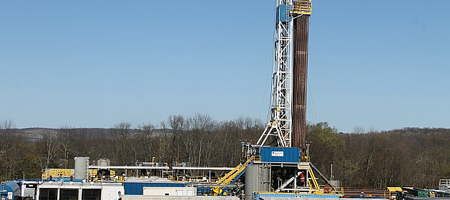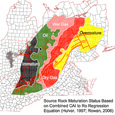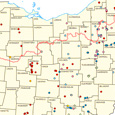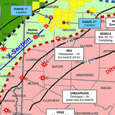Shale-gas Development and Soil Constraints
Tuesday, September 25, 2012

UNIVERSITY PARK, Pa. — Across the Appalachian Plateau in Pennsylvania, 50 to 70 percent of shale gas pads are being developed on slopes that could be prone to erosion and sedimentation problems, according to researchers in Penn State’s College of Agricultural Sciences.
Erosion
The potential for erosion problems is substantial because of the extensive scale of the shale gas play, said Patrick Drohan, assistant professor of pedology, who was the principle investigator in a recent 12-month study of the hydrologic implications of gas-well development and its effect on the plateau’s landscapes and soils.
“Even though between 50 and 70 percent of the pads are being constructed on soils and slopes at risk for excess water movement and erosion, that doesn’t mean all sites are having problems,” he said.
“It just means that we have identified a large number of sites that have to be watched because there could be trouble if state Department of Environmental Protection best-management practices to limit erosion and sedimentation are not implemented quickly or effectively.”
About 10 percent of locations where pads are built occur in high-risk locations for surface erosion and resulting sedimentation due to slopes greater than 8 percent, the study found. Drohan worries about such areas every time there is an intense rain event.
“Perhaps a statewide weather forecasting system for predicting the 24- to 72-hour risk of heavy rains — which could result in erosion and sedimentation — might help land managers and gas companies that are developing such areas to avoid problems,” he said.
Investigation
Researchers used a geographic information system to investigate topographic and soil characteristics across existing and permitted well locations where shale gas pads are being developed in Pennsylvania. These characteristics could affect infrastructure development and reclamation success.
They also used aerial photography to analyze the extent of surface disturbance associated with pad development and hydrologic modeling to assess potential erosion and sedimentation problems.
Most soils on the Allegheny Plateau, where shale gas development is concentrated, are acidic, rocky, shallow and of poor fertility, the study points out.
About a quarter of the sites are underlain by a “fragipan subsurface horizon” that restricts downward root growth and water movement.
“This presents unique challenges for gas developers and land managers because such soils can become even more problematic for plant growth and good drainage following disturbance,” Drohan said.
“Allegheny Plateau soils have been difficult to manage throughout Pennsylvania’s history and have typically been less productive than many agricultural soils elsewhere in the state.”
Wet soils
Another factor that concerns researchers is that 21 percent of pads have been developed on potentially wet soils, where drainage problems around the site could result in the loss of amphibian habitat. These locations potentially have a water table within 18 inches of the surface, Drohan noted.
“Our results do not suggest that we are losing wetlands, because well drillers are required to look for and avoid wetlands before they develop pads,” he said.
“However, such places would be what soil scientists consider hydrologically active locations. Development in such areas could disrupt local water movement around pad sites and other infrastructure and the recharge to nearby headwater streams, as well as present unique reclamation challenges down the road due to those sites’ inherent wetness.”
Drohan noted that researchers now are working with government agencies, such as the state Department of Conservation and Natural Resources, and community groups to improve decisions about where well pads are placed to help minimize the disruption of landscapes and reduce potential erosion and sedimentation.
Drilling pads
For example, one aspect of current research is evaluating the success of temporary and permanent restoration of infrastructure. So far, few Marcellus drilling pads have been reclaimed, but many other types of infrastructure — such as pipelines and water impoundments –have been.
“During reclamation of shale gas infrastructure, companies are using traditional amendments of fertilizer and lime to get the grass mixes to grow,” he said. “We are concerned, however, about altering the inherently acidic and low-fertility soils of the Allegheny Plateau to such a degree that the growth of invasive plant species becomes potentially more favorable than native species.”
Drohan and colleagues also have begun to focus their attention on ecological disruption caused by shale gas infrastructure, such as pipelines, that often traverses steep slopes and poorly drained areas.
“Measuring the effect of shale gas development, its extensive landscape footprint and rate of growth would really benefit from better data on pipelines,” he said.
There is currently no statewide tracking of the various types of pipelines developed to support the natural-gas industry. Federal supply lines are mapped, and one or two counties have been tracking shale gas pipelines.
“We now think that pad development is a lesser landscape disruption than the pipelines, and statewide pipeline tracking really would help land managers and researchers better understand their potential effect on ecosystems.”
The study was funded by the Heinz Endowment.




